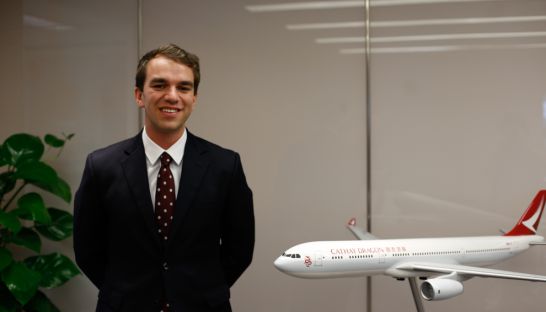Business Insider: Cathay Dragon spreads its wings
Business Insider: Cathay Dragon spreads its wings
For over two decades, Cathay Dragon – formerly Dragonair – has been connecting Cambodia to its hub in Hong Kong. The Post’s Alessandro Marazzi Sassoon spoke to Josh Williams, country manager of Cathay Dragon, a wholly owned subsidiary of Cathay Pacific Airways, about the airline group’s business outlook on Cambodia and its vision for the future.

How does Cambodia as a market compare to the rest of the region?
I’ve been here for a year. Before that I’ve worked in many places around the world with Cathay Pacific, including Hong Kong for a couple of years, Indonesia in Surabaya and Bali, also Mumbai. In Cambodia, as a market, there’s a lot of growth at the moment and we’re very bullish about the market.
Cathay Dragon has grown significantly since it first started serving Cambodia in 1993 with two flights a week. Most recently, we’ve increased our frequency between Phnom Penh and Hong Kong to two flights every day. Siem Reap will be moving to a daily service from October. Meanwhile, Cathay Pacific operates two cargo freighters every week. So I think our growth record really speaks for itself and we’re really optimistic about the future in Cambodia.
Siem Reap and Phnom Penh have both shown significant increases in passenger numbers so far this year driven in particular by an increase in China traffic, which we’re very well placed to serve as we’ve got an extensive network in China of 29 destinations.
To what extent is Cathay Pacific Group positioning itself as a vessel for investment from Hong Kong to Cambodia?
The link between Hong Kong and Cambodia is crucial to our business. We believe that travelling well is a crucial part of living well, so our main focus in Cambodia is to deliver a life-well-travelled to our Cambodian passengers. We do that primarily by providing them with an extensive global network and our award-winning product and service, and also great value.
Cathay Pacific is one of more than half a dozen airlines that provide international cargo service to Cambodia. How competitive is this segment of the business?
We started the first-ever international cargo freighter service to Cambodia with twice-weekly service to Phnom Penh in 2014 and that’s done very well for us.
There has been an increase in competition since then, but we’re still staying ahead by providing a greater range of products and services to our customers in Cambodia. For example, we were the first airline in Cambodia to obtain a licence to carry dangerous goods, and we are still the only airline to have received TSA [US Transportation Security Administration] accreditation in Cambodia, providing greater security and efficiency for our customers shipping to North America.
What does a dangerous goods licence cover?
Dangerous goods are cargo shipments that require an extra level of care to handle. Recently, for example, we handled some ammunition from one of our exporters.
Is there any concern that potential instability resulting from next year’s national election could dampen the Cambodian market?
The election is clearly a significant event that’s upcoming, however, ultimately we remain very optimistic about the market. Phnom Penh and Siem Reap are both growing very fast in terms of passenger numbers, and as I mentioned earlier, this is particularly driven by China. Chinese investment in Cambodia is growing very strongly and that’s great for us, because we’re well placed to serve the Chinese market.
Ultimately we take a long-term view and we’re very optimistic about the future in Cambodia.
Is there anything else you would like to add?
We’ll be adding 32 new Airbus A321neo to our fleet from 2020. That is an aircraft that is perfect for deployment on Cambodian routes, so that will help us supply the local market.













